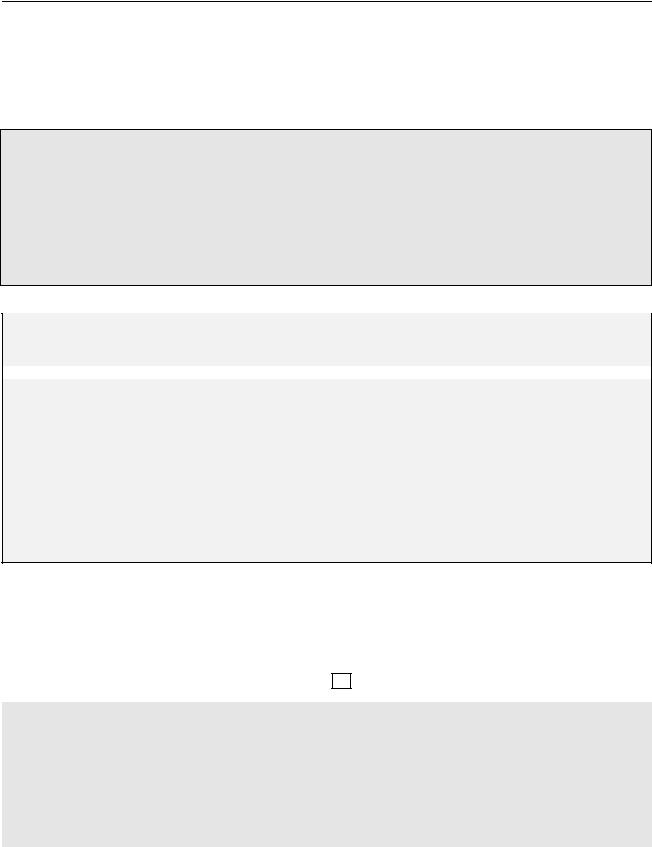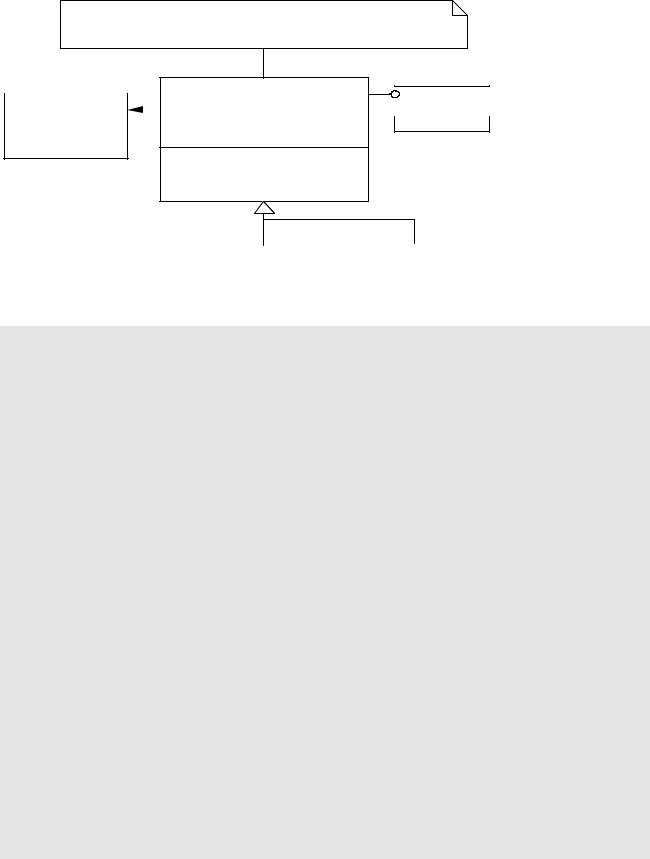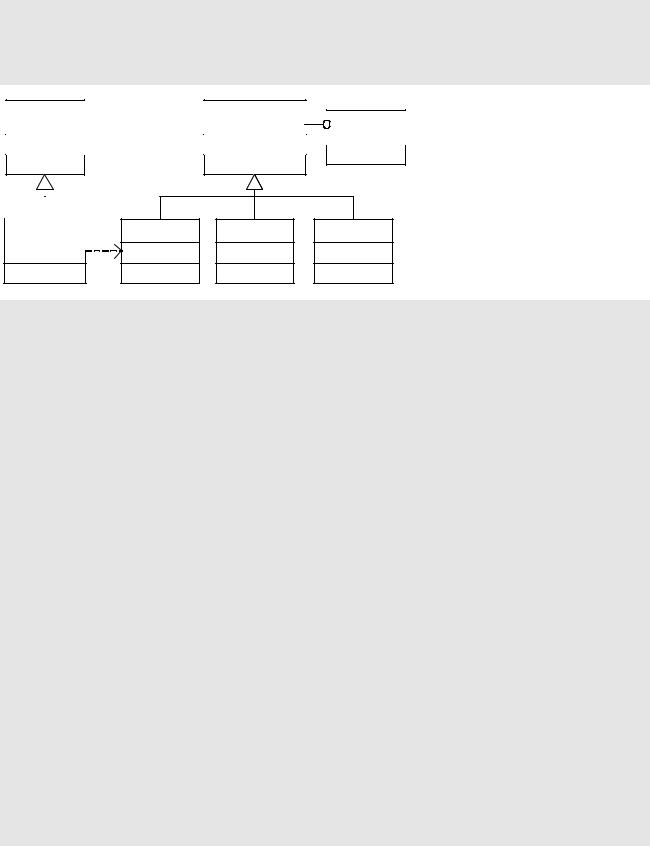
Java_J2EE_Job_Interview_Companion
.pdf
250 |
How would you go about …? |
Q. What is a use case specification document? What should it cover?
A use case diagram shown above is a visual depiction of the different scenarios of interaction between an actor and a use case. A use case specification document should enable you to easily document the business flow. Information that you document in a use case specification should include what actors are involved, the steps that the use case performs, business rules, and so forth. A use case specification document should cover the following:
•Actors: List the actors that participate and interact in this use case.
•Pre-conditions: Pre-conditions that need to be satisfied for the use case to perform.
•Post-conditions: Define the different states in which you expect the system to be in, after the use case executes.
•Basic Flow: List the basic events that will occur when the use case is executed. List all primary activities that the use case will perform and describe the actions performed by the actor and the response of the use case to those actions. These will form the basis for writing the test cases for the system.
•Alternative Flows: Any subsidiary events that can occur in the use case should be listed separately.
•Special requirements: Business rules for the basic and alternative flows should be listed as special requirements. These business rules will also be used to write test cases. Both success and failure scenarios should be described here.
•Use case relationships: For complex systems, you need to document the relationships between use cases.
Q. What are the “Do”s and “Don’t”s of a use case diagram?
•Use cases should not be used to capture all the details of a system. The granularity to which you define use cases in a diagram should be enough to keep the use case diagram uncluttered.
•Use cases are meant to capture “what” the system is and not “how” the system will be designed or built. Use cases should be free of any design characteristics.
What is the main |
Refer Q107 in Enterprise section: |
||||
difference between the |
|
|
|
|
|
collaboration diagram |
Collaboration diagrams convey the same message as sequence diagrams but the collaboration |
||||
and the sequence |
diagrams focus on object roles instead of times in which the messages are sent. The sequence |
||||
diagram? |
diagram is time line driven. |
||||
|
|
||||
When to use various |
Refer Q107 in Enterprise section. |
||||
UML diagrams? |
Use case diagrams: |
||||
|
|||||
|
|
|
Determining the user requirements. New use cases often generate new requirements. |
||
|
|
|
Communicating with clients. The simplicity of the diagram makes use case diagrams a |
||
|
|
|
good way for designers and developers to communicate with clients. |
||
|
|
Generating test cases. Each scenario for the use case may suggest a suite of test |
|||
|
|
|
cases. |
||
|
|
Class diagrams: |
|||
|
|
|
Class diagrams are the backbone of Object Oriented methods. So they are used |
||
|
|
|
frequently. |
||
|
|
|
Class diagrams can have a conceptual perspective and an implementation perspective. |
||
|
|
|
During the analysis draw the conceptual model and during implementation draw the |
||
|
|
|
implementation model. |
||
|
Interaction diagrams (Sequence and/or Collaboration diagrams): |
||||
|
|
|
When you want to look at behavior of several objects within a single use case. If you |
||
|
|
|
want to look at a single object across multiple use cases then use statechart |
||
|
|
|
diagram as described below. |
||
|
|
State chart diagrams: |
|||
|
|
|
Statechart diagrams are good at describing the behavior of an object across several |
||
|
|
|
use cases. But they are not good at describing the interaction or collaboration between |
||
|
|
|
many objects. Use interaction and/or activity diagrams in conjunction with the statechart |
||
|
|
|
diagram to communicate complex operations involving multi-threaded programs etc. |
||
|
|
|
Use it only for classes that have complex state changes and behavior. |
|
|
|
|
|
For example: |
|
|
|
|
|
the User Interface (UI) control objects, Objects shared by multi-threaded |
programs etc. |
|

|
|
|
How would you go about …? |
251 |
|
|
|
|
|
|
|
|
|
Activity diagram: |
|
|
|
|
|
|
Activity and Statechart diagrams are generally useful to express complex operations. |
||
|
|
|
The great strength of activity diagrams is that they support and encourage parallel |
||
|
|
|
behavior. An activity and statechart diagrams are beneficial for workflow modeling with |
||
|
|
|
multithreaded programming. |
|
|
|
|
|
|
|
|
|
|
|
|
|
|
Q 10: |
How would you go about describing the software development processes you are familiar with? |
FAQ |
|
A 10: |
In addition to technical questions one should also have a good understanding of the software development |
||
process.
Question |
|
Answer |
|
|
|
What is the key |
|
Refer Q103 – Q105 in Enterprise section |
|||
difference between the |
|
|
|
|
|
waterfall approach and |
Waterfall approach is sequential in nature. The iterative approach is non-sequential and |
||||
the iterative approach |
incremental. The iterative and incremental approach has been developed based on the following: |
||||
to software |
|
|
|
|
|
development? How to |
• |
You can't express all your needs up front. It is usually not feasible to define in detail (that is, |
|||
decide which one to |
|
before starting full-scale development) the operational capabilities and functional characteristics |
|||
use? |
|
of the entire system. These usually evolve over time as development progresses. |
|||
|
|
• |
Technology changes over time. Some development lifecycle spans a long period of time |
||
|
|
|
during which, given the pace at which technology evolves, significant technological shifts may |
||
|
|
|
occur. |
|
|
|
|
• |
Complex systems. This means it is difficult to cope with them adequately unless you have an |
||
|
|
|
approach for mastering complexity. |
||
|
|
How to decide which one to use? |
|||
|
|
Waterfall approach is more suitable in the following circumstances: |
|||
|
|
|
• |
Have a small number of unknowns and risks. That is if |
|
|
|
|
|
• |
It has a known domain. |
|
|
|
|
• |
The team is experienced in current process and technology. |
|
|
|
|
• |
There is no new technology. |
|
|
|
|
• |
There is a pre-existing architecture baseline. |
|
|
|
• |
Is of short duration (two to three months). |
|
|
|
|
• |
Is an evolution of an existing system? |
|
The iterative approach is more suitable (Refer Q136 in Enterprise Section)
|
• |
Have a large number of unknowns and risks. So it pays to design, develop and test a |
|
|
|
vertical slice iteratively and then replicate it through other iterations. That is if |
|
|
|
• |
Integrating with new systems. |
|
|
• |
New technology and/or architecture. |
|
|
• |
The team is fairly keen to adapt to this new process. |
|
• |
Is of large duration (longer than 3 months). |
|
|
• |
Is a new system? |
|
|
|
||
Have you used |
Extreme Programming (or XP) is a set of values, principles and practices for rapidly developing high- |
||
extreme programming |
quality software that provides the highest value for the customer in the fastest way possible. XP is a |
||
techniques? Explain? |
minimal instance of RUP. XP is extreme in the sense that it takes 12 well-known software |
||
|
development "best practices" to their logical extremes. |
||
|
The 12 core practices of XP are: |
||
|
1. |
The Planning Game: Business and development cooperate to produce the maximum |
|
|
|
business value as rapidly as possible. The planning game happens at various scales, but the |
|
|
|
basic rules are always the same: |
|
|
|
Business comes up with a list of desired features for the system. Each feature is written |
|
|
|
out as a user story (or PowerPoint screen shots with changes highlighted), which gives |
|
|
|
the feature a name, and describes in broad strokes what is required. User stories are |
|
|
|
typically written on 4x6 cards. |
|
|
|
Development team estimates how much effort each story will take, and how much effort |
|
|
|
the team can produce in a given time interval (i.e. the iteration). |
|
252 |
|
|
How would you go about …? |
|
|
|
|
|
|
|
Business then decides which stories to implement in what order, as well as when and how |
|
|
|
often to produce production releases of the system. |
|
|
2. |
Small releases: Start with the smallest useful feature set. Release early and often, adding a |
|
|
|
few features each time. |
|
|
3. |
System metaphor: Each project has an organizing metaphor, which provides an easy to |
|
|
|
remember naming convention. |
|
|
4. |
Simple design: Always use the simplest possible design that gets the job done. The |
|
|
|
requirements will change tomorrow, so only do what's needed to meet today's requirements. |
|
|
5. |
Continuous testing: Before programmers add a feature, they write a test for it. Tests in XP |
|
|
|
come in two basic flavors. |
|
|
|
Unit tests are automated tests written by the developers to test functionality as they write |
|
|
|
it. Each unit test typically tests only a single class, or a small cluster of classes. Unit tests |
|
|
|
are typically written using a unit-testing framework, such as JUnit. |
|
|
|
Customer to test that the overall system is functioning as specified, defines |
|
|
|
acceptance tests (aka functional tests). Acceptance tests typically test the entire |
|
|
|
system, or some large chunk of it. When all the acceptance tests pass for a given user |
|
|
|
story, that story is considered complete. At the very least, an acceptance test could |
|
|
|
consist of a script of user interface actions and expected results that a human can run. |
|
|
|
Ideally acceptance tests should be automated using frameworks like Canoo Web test, |
|
|
|
Selenium Web test etc. |
|
|
6. |
Refactoring: Refactor out any duplicate code generated in a coding session. You can do this |
|
|
|
with confidence that you didn't break anything because you have the tests. |
|
|
7. |
Pair Programming: All production code is written by two programmers sitting at one machine. |
|
|
|
Essentially, all code is reviewed as it is written. |
|
|
8. |
Collective code ownership: No single person "owns" a module. Any developer is expected to |
|
|
|
be able to work on any part of codebase at any time. |
|
|
9. |
Continuous integration: All changes are integrated into codebase at least daily. The tests |
|
|
|
have to run 100% both before and after integration. You can use tools like Ant, CruiseControl, |
|
|
|
and/or Maven to continuously build and integrate your code. |
|
|
10. |
40-Hour Workweek: Programmers go home on time. In crunch mode, up to one week of |
|
|
|
overtime is allowed. But multiple consecutive weeks of overtime are treated as a sign that |
|
|
|
something is very wrong with the process. |
|
|
11. |
On-site customer: Development team has continuous access to a real live customer or |
|
|
|
business owner, that is, someone who will actually be using the system. For commercial |
|
|
|
software with lots of customers, a customer proxy (usually the product manager, Business |
|
|
|
Analyst etc) is used instead. |
|
|
12. |
Coding standards: Everyone codes to the same standards. Ideally, you shouldn't be able to |
|
|
|
tell by looking at it, which developer on the team has touched a specific piece of code. |
|
|
A typical extreme programming project will have: |
|
|
|
• |
All the programmers in a room together usually sitting around a large table. |
|
|
• |
Fixed number of iterations where each iteration takes 1-3 weeks. At the beginning of each |
|
|
|
iteration get together with the customer. |
|
|
• |
Pair-programming. |
|
|
• |
Writing test cases first (i.e. TDD – Test Driven Development). |
|
|
• |
Delivery of a functional system at the end of 1-3 week iteration. |
|
|
|
|
|
Have you used agile |
Agile (i.e. lightweight) software development process is gaining popularity and momentum |
|
|
(i.e. Lightweight) |
across organizations. Several methodologies fit under this agile development methodology banner. |
|
|
software development |
All these methodologies share many characteristics like iterative and incremental development, |
|
|
methodologies? |
test driven development (i.e. TDD), stand up meetings to improve communication, automatic |
|
|
|
testing, build and continuous integration of code etc. Among all the agile methodologies XP is |
|
|
|
the one which has got the most attention. Different companies use different flavors of agile |
|
|
|
methodologies by using different combinations of methodologies (e.g. primarily XP with other |
|
|
|
methodologies like Scrum, FDD, TDD etc). Refer Q136 in Enterprise section. |
|
|
|
|
|

How would you go about …? |
253 |
Q 11: How would you go about applying the design patterns in your Java/J2EE application?
A 11: It is really worth reading books and articles on design patterns. It is sometimes hard to remember the design patterns, which you do not use regularly. So if you do not know a particular design pattern you can always honestly say that you have not used it and subsequently suggest that you can explain another design pattern, which you have used recently or more often. It is always challenging to decide, which design pattern to use when? How do you improve your design pattern skills? Practice, practice, practice. I have listed some of the design patterns below with scenarios and examples:
To understand design patterns you need to have a basic understanding of object-oriented concepts like:
Decomposition: The process of dividing a problem into smaller pieces (i.e. divide and conquer approach). The following examples will break different scenarios into objects, each with specific responsibilities. A good decomposition will often result in improved reusability.
Polymorphism, Inheritance, and Encapsulation: Refer Q10 in Java section.
Loose coupling: The process of making objects independent of each other rather than dependent of one another. Loosely coupled objects are easier to reuse and change.
Note: To keep it simple, System.out.println(…) is used. In real practice, use logging frameworks like log4j. Also package constructs are not shown. In real practice, each class should be stored in their relevant packages like com.items etc. Feel free to try these code samples by typing them into a Java editor of your choice and run the main class Shopping. Also constants should be declared in a typesafe manner as shown below:
/**
* use typesafe enum pattern as shown below if you are using below J2SE 5.0 or use “enum” if you are using J2SE 5.0
*/
public class ItemType { private final String name;
public static final ItemType Book = new ItemType("book"); public static final ItemType CD = new ItemType("cd");
public static final ItemType COSMETICS = new ItemType("cosmetics"); public static final ItemType CD_IMPORTED = new ItemType("cd_imported");
private ItemType(String name) {this.name = name;} public String toString() {return name;}
//add compareTo(), readResolve() methods etc as required ...
}
Scenario: A company named XYZ Retail is in the business of selling Books, CDs and Cosmetics. Books are sales tax exempt and CDs and Cosmetics have a sales tax of 10%. CDs can be imported and attracts an import tax of 5%. Write a shopping basket program, which will calculate extended price (qty * (unitprice + tax)) inclusive of tax for each item in the basket, total taxes and grand total.
Solution: Sample code for the items (i.e. Goods) sold by XYZ Retail. Let’s define an Item interface to follow the design principle of code to an interface not to an implementation. CO
public interface Item {
public static final int TYPE_BOOK = 1; public static final int TYPE_CD = 2;
public static final int TYPE_COSMETICS = 3; public static final int TYPE_CD_IMPORTED = 4;
public double getExtendedTax();
public double getExtendedTaxPrice() throws ItemException; public void setImported(boolean b);
public String getDescription();
}
The following class Goods cannot be instantiated (since it is abstract). You use this abstract class to achieve code reuse.


How would you go about …? |
255 |
public class Book extends Goods { private boolean isTaxed = false; private boolean isImported = false;
public Book(String description, int qty, double price) { super(description, qty, price);
}
public boolean isTaxed() { return isTaxed;
}
public boolean isImported() { return isImported;
}
public void setImported(boolean b) { isImported = b;
}
}
public class CD extends Goods { private boolean isTaxed = true;
private boolean isImported = false;
public CD(String description, int qty, double price) { super(description, qty, price);
}
public boolean isTaxed() { return isTaxed;
}
public boolean isImported() { return isImported;
}
public void setImported(boolean b) { isImported = b;
}
}
public class Cosmetics extends Goods { private boolean isTaxed = true; private boolean isImported = false;
public Cosmetics(String description, int qty, double price) { super(description, qty, price);
}
public boolean isTaxed() { return isTaxed;
}
public boolean isImported() { return isImported;
}
public void setImported(boolean b) { isImported = b;
}
}
Alternative solution: Alternatively, instead of using inheritance, we can use object composition to achieve code reuse as discussed in Q10 in Java section. If you were to use object composition instead of inheritance, you would have classes Book, CD and Cosmetics implementing the Item interface directly (Goods class would not be required), and make use of a GoodsHelper class to achieve code reuse through composition.

256 |
How would you go about …? |
interface inheritance where code reuse is achieved through composition [GoodsHelper]. code not shown.
|
|
|
|
|
GoodsHelper |
|
|
|
|
|
|
|
|
|
|
|
|
|
|
|
|
|
|
|
|
|
|
|
|
|
|
|
|
1 |
|
|
|
1 |
|
|
|||
|
|
|
|
|
|
|||||
|
1 |
|
1 |
|
|
|
1 |
|
||
|
|
|
|
|
|
|
|
|
|
|
CD |
|
|
|
Book |
|
Cosmetics |
||||
|
|
|
|
|
|
|
|
|
|
|
-isTaxed : boolean |
|
-isTaxed : boolean |
|
-isTaxed : boolean |
||||||
-isImported : boolean |
|
-isImported : boolean |
|
-isImported : boolean |
||||||
-helper : GoodsHelper |
|
-helper : GoodsHelper |
|
-helper : GoodsHelper |
||||||
|
|
|
|
|
|
|
|
|
|
|
«interface»
Item
Let’s define a Tax class, which is responsible for calculating the tax. The Tax class is composed in your Goods class, which makes use of object composition to achieve code reuse.
public class Tax {
//stay away from hard coding values. Define constants or read from a “.properties” file public static final double SALES_TAX = 0.10; //10%
public static final double IMPORT_TAX = 0.05; //5%
private double salesTax = 0.0; private double importTax = 0.0;
public void calculate(boolean isTaxable, boolean isImported, double price) { if (isTaxable) {
salesTax = price * SALES_TAX;
}
if (isImported) {
importTax = price * IMPORT_TAX;
}
}
public double getTotalUnitTax() {
return this.salesTax + this.importTax;
}
}
Factory method pattern: To create the items shown above we could use the factory method pattern as described in Q52 in Java section. We would also implement the factory class as a singleton using the singleton design pattern as described in Q51 in Java section. The factory method design pattern instantiates a class in a more flexible way than directly calling the constructor. It loosely couples your calling code from the Items it creates like CD, Book, etc. Let’s look at why factory method pattern is more flexible:
Sometimes factory methods have to return a single instance of a class instead of creating new objects each time or return an instance from a pool of objects.
Factory methods have to return a subtype of the type requested. It also can request the caller to refer to the returned object by its interface rather than by its implementation, which enables objects to be created without making their implementation classes public.
Sometimes old ways of creating objects can be replaced by new ways of creating the same objects or new classes can be added using polymorphism without changing any of the existing code which uses these objects. For example: Say you have a Fruit abstract class with Mango and Orange as its concrete subclasses, later on you can add an Apple subclass without breaking the code which uses these objects.

How would you go about …? |
257 |
The factory method patterns consist of a product class hierarchy and a creator class hierarchy.
/**
* ItemFactory is responsible for creating Item objects like CD, Book, and Cosmetics etc */
public abstract class ItemFactory {
public abstract Item getItem(int itemType, String description, int qty, double price) throws ItemException;
} |
|
|
|
<<abstract>> |
<<abstract>> |
«interface» |
|
ItemFactory |
Goods |
||
Item |
|||
|
|
||
+getItem() |
|
|
|
|
|
|
|
|
|
|
|
|
|
|
|
|
|
|
|
|
|
|
|
|
|
|
|
|
|
|
|
|
|
|
|
|
|
|
|
|
|
|
|
|
|
|
|
GoodsFactory |
|
|
|
|
|
|
|
|
CD |
|
Book |
|
Cosmetics |
|
|
|
|
|
|
|
|
|
|
|
|
|
|
|
|
|
|
|
|
|
|
|
|
|
|
|
|
|
|
|
|
|
|
|
|
|
|
|
|
|
|
|
|
|
|
+getItem()
/**
* GoodsFactory responsible for creating Item objects like CD, Book, and Cosmetics etc */
public class GoodsFactory extends ItemFactory {
protected GoodsFactory() { } //protected so that only ItemFactorySelector within this package can //instantiate it to provide a single point of access
//(i.e. singleton).
/**
*Factory method, which decides how to create Items.
*Benefits are: -- loosely-couples the client (i.e. ShoppingBasketBuilder class) from Items such
*as CD, Book, and Cosmetics etc. In future if we need to create a Book item, which is imported,
*we can easily incorporate this by adding a new item.TYPE_BOOK_IMPORTED and subsequently adding
*following piece of code as shown:
*
*else if(itemType == TYPE_BOOK_IMPORTED){
*item = new Book(description, qty,price);
*item.setIsImported(true);
*}
*
*-- It is also possible to create an object cache or object pool of our items instead of creating a new instance
*every time without making any changes to the calling class.
*-- Java does not support overloaded constructors which take same parameter list. Instead, use several factory methods.
*E.g. getImportedItem(int itemType, String description, int qty, double price), getTaxedItem (int itemType ….) etc
*/
public Item getItem(int itemType, String description, int qty, double price) throws ItemException
{
Item item |
= null; |
//code to interface |
||||
if (itemType == |
Item.TYPE_BOOK) |
{ |
|
|||
item |
= |
new |
Book(description, qty, price); |
|||
} else if |
(itemType == Item.TYPE_CD) |
{ |
||||
item |
= |
new |
CD(description, |
qty, |
price); |
|
}else if (itemType == Item.TYPE_CD_IMPORTED) { item = new CD(description, qty, price); item.setImported(true);
}else if (itemType == Item.TYPE_COSMETICS) {
item = new Cosmetics(description, qty, price); } else {
throw new ItemException("Invalid ItemType=" + itemType);
}
return item; //returned object is referred by its interface instead of by its implementation
}
}

258 |
How would you go about …? |
Let’s use the abstract factory pattern to create an ItemFactory and the singleton pattern to provide a single point of access to the ItemFactory returned.
Abstract factory pattern: This pattern is one level of abstraction higher than the factory method pattern because you have an abstract factory (or factory interface) and have multiple concrete factories. Abstract factory pattern usually has a specific method for each concrete type being returned (e.g. createCircle(), createSquare() etc). Alternatively you can have a single method e.g. createShape(…).
Singleton pattern: Ensures that a class has only one instance and provides a global point of access to it (Refer Q51 in Java section). E.g. a DataSource should have only a single instance where it will supply multiple connections from its single DataSource pool.
/**
*Abstract factory class which creates a singleton ItemFactory dynamically based on factory name
*supplied.
*Benefits of singleton: -- single instance of the ItemFactory -- single point of access (global
*access within the JVM and the class loader)
*/
public class ItemFactorySelector {
private static ItemFactory objectFactorySingleInstance = null;
private static final String FACTORY_NAME = "com.item.GoodsFactory"; //can use a .proprties file.
public static ItemFactory getItemFactory() { try {
if (objectFactorySingleInstance == null) {
//Dynamically instantiate factory and factory name can also be read from a properties //file. in future if we need a CachedGoodsFactory which caches Items to improve memory //usage then we can modify the FACTORY_NAME to "com.item.CachedGoodsFactory" or //conditionally select one of many factories.
Class klassFactory = Class.forName(FACTORY_NAME); objectFactorySingleInstance = (ItemFactory) klassFactory.newInstance();
}
}
catch (ClassNotFoundException cnf) {
throw new RuntimeException("Cannot create the ItemFactory: " + cnf.getMessage()); }catch (IllegalAccessException iae) {
throw new RuntimeException("Cannot create the ItemFactory: " + iae.getMessage()); }catch (InstantiationException ie) {
throw new RuntimeException("Cannot create the ItemFactory: " + ie.getMessage());
}
return objectFactorySingleInstance;
}
}
Now we should build a more complex shopping basket object step-by-step, which is responsible for building a basket with items like CD, Book etc and calculating total tax for the items in the basket. The builder design pattern is used to define the interface ItemBuilder and the concrete class, which implements this interface, is named ShoppingBasketBuilder.
Builder pattern: The subtle difference between the builder pattern and the factory pattern is that in builder pattern, the user is given the choice to create the type of object he/she wants but the construction process is the same. But with the factory method pattern the factory decides how to create one of several possible classes based on data provided to it.
…//package & import statements
public interface ItemBuilder {
public void buildBasket(int itemType, String description, int qty, double unit_price) throws ItemException;
public double calculateTotalTax() throws ItemException; public double calculateTotal() throws ItemException;
public void printExtendedTaxedPrice() throws ItemException; public Iterator getIterator();
}

How would you go about …? |
259 |
ItemBuilder
+buildBasket()
+calculateTotalTax()
+calculateTotal()
+printExtendedTax()
+getItemIterator()
|
|
|
|
aProduct : Item |
ShoppingBasketBuilder |
|
|
|
|
|
|
* |
||
|
|
|
|
|
-listItems : List |
|
|
|
|
|
|
+buildBasket() 1 +calculateTotalTax() «call»
+calculateTotal() ItemFactory +printExtendedTax() 

+getItemIterator()
+getItem()
GoodsFactory
aProduct:Item
+getItem()
+getInstance()
…//package & import statements
/**
*Builder pattern: To simplify complex object creation by defining a class whose purpose is to
*build instances of another class.
*There is a subtle difference between a builder pattern and the factory pattern is that in builder
*pattern, the user is given the choice to create the type of object he/she wants but the
*construction process is the same. But with the factory method pattern the factory decides how to
*create one of several possible classes based on data provided to it.
*/
public class ShoppingBasketBuilder implements ItemBuilder {
private List listItems = null;
private void addItem(Item item) { if (listItems == null) {
listItems = new ArrayList(20);
}
listItems.add(item);
}
/**
* builds a shopping basket
*/
public void buildBasket(int itemType, String description, int qty, double unit_price) throws ItemException {
//get the single instance of GoodsFactory using the singleton pattern
//no matter how many times you call getInstance() you get access to the same instance.
ItemFactory factory = ItemFactorySelector.getItemFactory();
//use factory method pattern to create item objects, based on itemType supplied to it.
Item item = factory.getItem(itemType, description, qty, unit_price); this.addItem(item); //adds the item to the basket
}
/**
* calculates total tax on the items in the built basket
*/
public double calculateTotalTax() throws ItemException {
if (listItems == null) {
throw new ItemException("No items in the basket");
